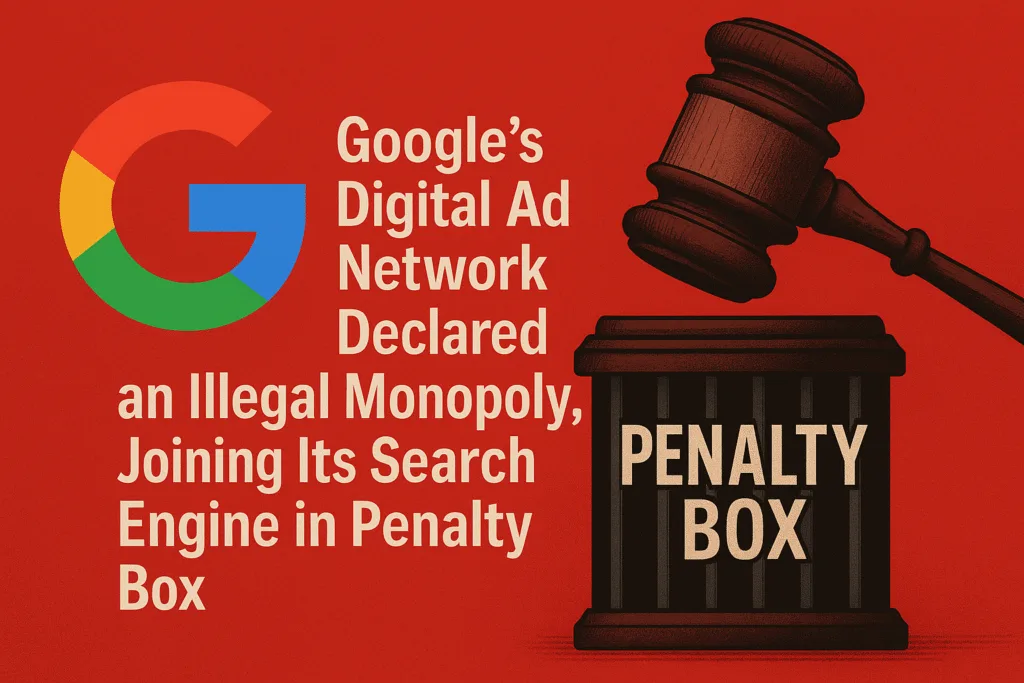
In a landmark decision that could reshape the digital advertising landscape, Google’s digital ad network has been declared an illegal monopoly, adding to the growing list of antitrust challenges faced by the tech giant. The ruling comes as part of a broader crackdown on Google’s influence in the online advertising and search engine markets, sending a strong signal that regulatory bodies are taking serious action to address monopolistic practices in the digital space.
The United States Department of Justice (DOJ), along with several state attorneys general, launched an investigation into Google’s business practices in the online advertising sector. The probe concluded that Google had unlawfully used its dominance to control the flow of digital ads, suppress competition, and manipulate ad pricing, resulting in unfair advantages for its own services over those of competitors.
The crux of the issue lies in Google’s ability to control multiple layers of the digital advertising ecosystem. From ad bidding and placement to ad targeting and analytics, Google’s overwhelming market share allowed it to manipulate pricing and stifle competition from smaller ad networks.
This decision marks a major blow to Google’s position in the advertising world, as it now faces pressure to relinquish certain aspects of its advertising business and restructure how it operates in this space.
This isn’t Google’s first brush with regulatory scrutiny. Its search engine monopoly has already faced several legal challenges in both the US and Europe. Critics argue that Google’s dominant search engine practices limit consumer choice and suppress competition by unfairly prioritizing its own products and services in search results.
In 2020, the DOJ filed an antitrust lawsuit claiming that Google used its dominance in search to restrict competitors and maintain its market share. While Google continues to defend its practices as part of the free market, the EU and US regulators have taken issue with the company’s business strategies.
Both the ad network and search engine rulings underscore the growing concern that Google’s extensive reach across various digital platforms stifles competition and harms consumers.

This legal decision could have profound implications for Google’s advertising division. Here’s what might happen next:
With its ad network now under the microscope, Google will likely face increased regulatory pressure. Authorities could impose stricter rules on how Google buys and sells ads, potentially forcing the company to break up some of its ad technologies.
One possible outcome is that Google may be required to spin off parts of its advertising business to restore competition. The company could face the prospect of losing control over certain advertising tools and technologies.
This ruling could set a precedent for the digital ad sector. Other companies, such as Facebook and Amazon, may find themselves under similar scrutiny as regulators seek to curb monopolistic behaviors in the online advertising space.
Smaller ad networks and platforms may now have a clearer path to compete with Google, fostering innovation and diversity in the digital marketing ecosystem. Advertisers could gain more flexibility in choosing ad services that aren’t as heavily controlled by one dominant player.
For businesses and marketers, this ruling could mean a shift in how they approach digital advertising. As Google faces increased competition and regulatory oversight, advertisers may benefit from:
Lower ad costs: With a reduction in Google’s monopolistic practices, advertisers could see more competitive pricing in ad auctions.
Diverse ad options: Marketers may gain access to a broader range of advertising platforms that are less controlled by Google’s dominance.
Greater transparency: Stricter regulations on Google’s ad network could lead to clearer data and more transparency in how ads are sold and placed.
This ruling is a pivotal moment in the ongoing antitrust battle against Google. As the company faces increasing scrutiny, we may see it alter its business practices to comply with new regulations. However, Google has already signaled its intention to appeal the decision, meaning this legal saga is far from over.
This ruling adds to a growing wave of antitrust actions against major tech companies around the world. The European Union has already taken strong action against Google, imposing hefty fines for similar practices. Other tech giants, such as Amazon and Apple, are also facing their own regulatory battles as governments worldwide seek to rein in their dominance.
In the coming years, tech companies may face a more complex and restrictive regulatory environment. The digital ad market is likely to evolve as a result, with opportunities for smaller players to gain traction in what has traditionally been a Google-dominated space.
The ruling declaring Google’s digital ad network an illegal monopoly marks a significant turning point for the company and the broader digital marketing industry. As regulators continue to scrutinize Google’s business practices, the digital ad space may become more competitive and transparent, offering new opportunities for advertisers and a better deal for consumers.
The future of Google’s dominance in the advertising world is uncertain, but one thing is clear — the digital ad landscape is evolving, and it may look very different in the years to come.